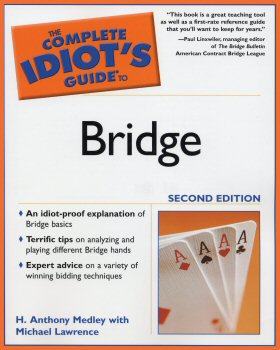| The first edition of Complete Idiot's Guide to Bridge by H. Anthony Medley was the fastest selling beginning bridge book, going through more than 10 printings. This updated Second Edition includes some modern advanced bidding systems and conventions, like Two over One, a system used by many modern tournament players, Roman Key Card Blackwood, New Minor Forcing, Reverse Drury, Forcing No Trump, and others. Also included is a detailed Guide to Bids and Responses, along with the most detailed, 12-page Glossary ever published, as well as examples to make learning the game even easier. Click book to order. | ||
| Last Chance Harvey (7/10) by Tony Medley Run Time 92 Minutes. There are two scenes that set this up and one that lets it down. “John and Mary” (1969) was Dustin Hoffman’s third starring role, after “The Graduate” (1967) and “Midnight Cowboy” (1969). In it, he (John) hits on Mary (Mia Farrow) in a singles bar, making a fool out of himself in front of Mary’s friends. But Mary finds something sympathetic and a relationship is formed. But it’s painful for John before Mary takes pity on him. One of the most memorable scenes in “Kramer vs. Kramer” (1979) showed Dustin (Mr. Kramer) sitting in his attorney’s office during a Christmas party. He was angry and upset and everyone else was in revelry. The scene I remember vividly is Dustin sitting outside his lawyer’s office door, waiting for him, while everyone else is partying it up. He is as alone as alone can be in the midst of a crowd. Dustin does this alone-in-a-crowd business exceptionally well. Here, Harvey Schine (Hoffman) is at his daughter’s pre-marital party and he’s so alone and uncomfortable, surrounding by yuletide gaiety, that his loneliness is palpable. He and his ex-wife have been separated for years and Harvey’s daughter is going to be given away by her stepfather, Brian (James Brolin). He is clearly the outsider. He’s as uncomfortable and alone at the wedding party as John and Kramer were. In the related scene, Kate Walker (Emma Thompson, who gives her usual superb performance; in fact, she carries the movie) is being fixed up with a younger man. She is uncomfortable with him. Her friends have to leave suddenly, leaving her alone with him. But shortly some of his friends arrive and join them. Kate is as alone amidst laughter and fun as John and Kramer and Harvey. The third scene that lets the movie down occurs after a rather contentious first meeting and after the two setup scenes outlined above. Both Harvey and Kate show up at the same bar. Harvey sees and recognizes her and makes his approach. This is where Dustin loses me. The dialogue is pretty good, but Hoffman’s delivery misses the mark. He’s smiling and winking and trying to be coy and cute like Hugh Grant, but it is dismally unbelievable. You can almost hear the director telling him how to act through a megaphone. I was squirming as Harvey was continuing to try to make a connection with Kate despite her repeated rejections. In “John and Mary,” John is supposed to be inept. The point is that he is as bad at hustling as any man’s worst nightmare, but Mary is sweet and finds his clumsiness attractive. Here, Harvey is intended to be a suave and cool cat, persevering despite Kate’s continuous rejections. After that, though, this is a sweet, if incredible, love story between an elderly man (Dustin is 71 as of this writing) and a middle-aged woman (Emma is 49). If you haven’t already seen this story many times, you don’t go to the movies. Regis and Kelly could have this film as one of their spin the wheel questions, showing a scene and asking the audience what happens next. I would bet that 95% of them will get the answer. It’s so derivative that it even copies from the denouement from “An Affair to Remember” (1957). In addition to Hoffman’s bathetic hustling of Kate, there is a scene later on that is completely out of touch with reality. Kate convinces Harvey that he has to attend the reception so he, in turn, convinces her to go with him and offers to buy her a dress. Here’s the setup; the party has apparently already started, but first they go to a store to get her dress. Clearly time is of the essence here. But that doesn’t bother them as she tries on dress after dress. It’s not that they are all pretty dresses and she can’t decide. No, the first four are so outlandish that the idea that she would seriously even consider one as a possibility is beyond comprehension, a monument to bad taste, a fault which Kate clearly does not possess. Apparently these scenes of these horrible dresses are inserted for what director (who also wrote) Joel Hopkins must have thought comic relief. Not. It’s merely stupid because it’s incomprehensible that she would try on all these dresses when they were rushing to get to a party that had already started. That’s just one example of some of the old-fashioned tricks that Hopkins throws into the mix. I don’t have the space to list the others. It is unrealistic diversions like this that keep a film from being completely enjoyable. Even so, while lots of men will probably rue the day, I enjoyed it. But, then, I am nothing if not a patient movie aficionado (if I were Hoffman I’d be smiling and winking). December 23, 2008
|
||
|
|
||
